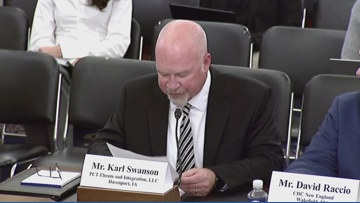Bridging Talent Gaps Across HR, Private Equity, and Higher Education: A Strategic Approach Aligned with Sustainable Development Goals

Introduction
June 26, 2025 – Organizations across various sectors face an urgent challenge: navigating critical talent gaps that impact growth, transformation, and operational continuity. According to Ruben Moreno of Blue Rock Search, securing the right executive talent is a vital competitive advantage. This report emphasizes the importance of addressing talent gaps strategically and sustainably, in alignment with the United Nations Sustainable Development Goals (SDGs), particularly SDG 8 (Decent Work and Economic Growth) and SDG 4 (Quality Education).
Understanding Talent Gaps and Their Impact
Talent gaps extend beyond unfilled positions; they represent missed opportunities, lost momentum, and increased organizational risk. Blue Rock Search identifies three primary forms of talent gaps:
- Succession Failures: Absence of ready successors for key executives, leading to operational and morale challenges.
- Misalignment with Growth Strategy: Leadership that may not support evolving organizational goals.
- Functional Deficiencies: Lack of expertise in critical areas such as Total Rewards or HR technology, hindering transformation efforts.
These gaps often result in organizations operating below their potential or struggling to catch up, impacting sustainable economic growth (SDG 8).
Manifestation of Talent Gaps Across Sectors
Private Equity
In private equity (PE), talent is a lever for growth with significant time constraints. Common talent gaps include:
- CEO turnover in newly acquired portfolio companies.
- CHRO vacancies during rapid scaling phases.
- Operational leadership gaps delaying post-acquisition execution.
Given PE’s investment horizons, every executive must perform immediately to preserve value and support sustained economic development (SDG 8).
Human Resources
The HR function is central to organizational transformation and vulnerable to talent gaps such as:
- Lack of strategic HR leadership.
- Functional gaps in total rewards, talent acquisition, or organizational development.
- Under-resourced HR teams post-merger or during expansion.
Strong HR leadership, especially experienced CHROs, is critical for compliance, culture, and talent retention, supporting SDG 8 and SDG 5 (Gender Equality) through inclusive leadership.
Higher Education
Universities and colleges face unique talent challenges including:
- Leadership transitions without succession planning.
- Aging senior leadership and retirements lacking pipelines.
- Functional voids in HR, enrollment, or student affairs.
Leadership in higher education influences culture, consensus, and mission, directly impacting quality education (SDG 4) and institutional sustainability.
Blue Rock Search’s Strategic Approach
Ruben Moreno leads Blue Rock Search’s HR executive search practice, specializing in identifying and recruiting chief HR officers and leadership teams for over 12 years. The firm’s approach integrates expertise across HR, private equity, and higher education to close talent gaps strategically and sustainably, aligning with SDG 8 and SDG 10 (Reduced Inequalities).
Cross-Sector Expertise
- Applying academic strategic thinking to private equity challenges.
- Bringing private equity executional precision to higher education.
- Combining functional HR knowledge with business operational insight.
This cross-pollination fosters smarter hiring strategies and better-aligned candidates, promoting sustainable organizational development.
Proactive Talent Mapping for Future Readiness
Blue Rock Search advocates for proactive talent mapping to anticipate needs and prevent costly reactive hiring. Their process includes:
- Defining future-state talent requirements.
- Conducting market research and salary benchmarking.
- Building candidate profiles and maintaining active pipelines.
- Engaging candidates well before roles are posted.
This forward-looking strategy supports SDG 8 by fostering decent work environments and sustainable economic growth.
Structured Process and Transparent Communication
To ensure effective executive searches, Blue Rock provides:
- Weekly cadence calls and search updates.
- Market insights and candidate pipeline visibility.
- Real-time access to candidate evaluations and status.
Transparent communication enables faster, smarter decision-making aligned with organizational goals.
Best Practices for Closing Talent Gaps
Blue Rock recommends the following strategic practices to close leadership gaps effectively:
- Start with Clarity: Define success beyond job descriptions, focusing on expected outcomes to guide hiring, onboarding, and retention.
- Invest in Market Intelligence: Utilize salary benchmarks, industry comparisons, and market trends to align expectations and avoid compensation misalignment.
- Treat Hiring as a Strategic Partnership: Collaborate closely with search partners who understand your industry and long-term objectives.
- Build a Leadership Pipeline: Develop a sustainable talent pipeline to future-proof leadership and respond to unexpected vacancies.
Commitment to Diversity and Inclusion
Blue Rock Search is a 100% minority and female-owned executive search firm and a member of the SRA Network. Recognized among the Hunt Scanlon HR/Diversity Recruiting Power 65, the firm emphasizes diversity and inclusion, supporting SDG 5 (Gender Equality) and SDG 10 (Reduced Inequalities) through equitable recruitment practices.
Conclusion
Addressing talent gaps in HR, private equity, and higher education requires a strategic, sustainable approach that aligns with the Sustainable Development Goals. Blue Rock Search’s integrated expertise, proactive talent mapping, and transparent processes enable organizations to transform vulnerabilities into opportunities, fostering sustainable growth, quality education, and inclusive leadership.
Contributed by Scott A. Scanlon, Editor-in-Chief, and Dale M. Zupsansky, Executive Editor – Hunt Scanlon Media
1. Sustainable Development Goals (SDGs) Addressed or Connected
- SDG 4: Quality Education
- Relevant due to the focus on higher education leadership, succession planning, and organizational development in universities and colleges.
- SDG 8: Decent Work and Economic Growth
- Addressed through the emphasis on closing talent gaps, leadership development, and strategic human resource management that supports organizational growth and operational continuity.
- SDG 5: Gender Equality
- Implied by Blue Rock Search being a 100% minority/female-owned firm and its focus on diversity recruiting.
- SDG 10: Reduced Inequalities
- Linked to diversity and inclusion efforts in executive search and recruitment processes.
2. Specific Targets Under Those SDGs Identified
- SDG 4: Quality Education
- Target 4.3: Ensure equal access to affordable and quality technical, vocational and tertiary education, including university.
- Target 4.7: Ensure that all learners acquire knowledge and skills needed to promote sustainable development, including leadership and organizational skills.
- SDG 8: Decent Work and Economic Growth
- Target 8.5: Achieve full and productive employment and decent work for all women and men, including young people and persons with disabilities, and equal pay for work of equal value.
- Target 8.6: Reduce the proportion of youth not in employment, education or training.
- Target 8.8: Protect labor rights and promote safe and secure working environments for all workers.
- SDG 5: Gender Equality
- Target 5.5: Ensure women’s full and effective participation and equal opportunities for leadership at all levels of decision-making in political, economic and public life.
- SDG 10: Reduced Inequalities
- Target 10.2: Empower and promote the social, economic and political inclusion of all, irrespective of age, sex, disability, race, ethnicity, origin, religion or economic or other status.
3. Indicators Mentioned or Implied to Measure Progress
- SDG 4 Indicators
- Indicator 4.3.1: Participation rate of youth and adults in formal and non-formal education and training in the previous 12 months.
- Indicator 4.7.1: Extent to which education for sustainable development is integrated at all levels.
- SDG 8 Indicators
- Indicator 8.5.2: Unemployment rate, by sex, age and persons with disabilities.
- Indicator 8.6.1: Proportion of youth not in education, employment or training.
- Indicator 8.8.1: Frequency rates of fatal and non-fatal occupational injuries, by sex and migrant status.
- SDG 5 Indicators
- Indicator 5.5.2: Proportion of women in managerial positions.
- SDG 10 Indicators
- Indicator 10.2.1: Proportion of people living below 50% of median income, by age, sex and persons with disabilities.
- Additional Implied Indicators
- Executive turnover rates (e.g., CEO, CHRO vacancies).
- Succession planning coverage and readiness.
- Leadership pipeline strength and diversity metrics.
- Employee retention and organizational performance metrics linked to leadership quality.
4. Table of SDGs, Targets, and Indicators
| SDGs | Targets | Indicators |
|---|---|---|
| SDG 4: Quality Education |
|
|
| SDG 8: Decent Work and Economic Growth |
|
|
| SDG 5: Gender Equality |
|
|
| SDG 10: Reduced Inequalities |
|
|
Source: huntscanlon.com







